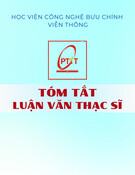
MINISTRY OF EDUCATION
AND TRAINING
VIETNAM ACADEMY
OF SCIENCE AND TECHNOLOGY
GRADUATE UNIVERSITY SCIENCE AND TECHNOLOGY
HOANG THU TRANG
DESIGN AND INVESTIGATION OF 1D, 2D PHOTONIC
CRYSTALS FOR BISTABLE DEVICES
Specialized: Materials for Optics Optoelectronics and Photonics
Numerical code: 9 44 01 27
SUMMARY OF SCIENCE MATERIALS DOCTORAL THESIS
Hanoi - 2020

9.
The thesis was completed at Key Laboratory for Electronic
Materials and Devices, Institute of Materials Science, Vietnam
Academy of Science and Technology.
Supervisors:
1. Assocc. Prof. Dr. Ngo Quang Minh
2. Prof. Dr. Arnan Mitchell
Reviewer 1:
Reviewer 2:
Reviewer 3:
The dissertation will be defended at Graduate University of
Science and Technology, 18 Hoang Quoc Viet street, Hanoi.
Time:...........,............., 2020
The thesis could be found at:
- National Library of Vietnam
- Library of Graduate University of Science and Technology
- Library of Institute of Science Materials

INTRODUCTION
1. The urgency of the thesis
Micro- and nano-structured photonic and optoelectronic devices
have been the great interests for their outstanding applications and
features in integrated micro-optoelectronic circuits with high
processing speed. Their unique properties have been expected to
realize the new generation of opto-electronic components with high
efficiency, low cost, and low energy consumption... [1-5]. There are
two main approaches to improve the efficiency, functionality and
reduce the cost of photonic and opto-electronic devices: (i) firstly of
using new structures for the core elements that build up the devices;
(ii) the other approach is the use of advanced materials with many
special features. Within the framework of my Ph.D. thesis in materials
science, speciality in optical materials, opto-electronics and photonics,
I will study in depth and present the use of new structures for photonic
materials and devices which have not been available in nature, for
applications in telecommunication and optical processing.
Photonics was appeared in the 80s of the XIX century [6] and
developed very actively in the XX century, especially since the
discovery of a new material with artificial structures such as photonic
crystals (PhCs), plasmonics and metameterials (MMs) [7-9]. The PhC
structure is the periodicity of elements with different dielectric
constants. The periodic of the refractive indices of the dielectric
materials enables the PhC structure can manupulate the light without
loss. The light/electromagnetic waves transmitted inside the PhC
structure interact with the periodic of the dielectric elements and create
the photonic bandgap (PBG). Light/electromagnetic waves with

frequencies (or wavelengths) in the PBG region cannot pass through
the PhC structure. Besides, we can easily capture, control, and direct
lights in the identical media as desired. Light/electromagnetic wave
propagation can be made in the PBG region by creating the cavities or
waveguides in the PhC structure. The cavity and the waveguide are
the key elements that build up the integrated optical and opto-
electronic components such as switches and optical processing that the
thesis will mention.
PhC structures have been studied and developed widely around the
world, particular the research group of Professor J.D. Joannopoulos at
Massachusetts Institute of Technology (USA) [10,11]. The group's
key research members come from different departments such as
Physics, Materials Science, Electronics and Computer Engineering,
Mathematics... Every year, many excellent publications are published
in high impact journals such as Science, Nature, Physical Review
Letters ... Many computational softwares have been known widely
such as MIT Photonic-Bands (MPB), MIT Electromagnetic Equation
Propagation (MEEP) [10,11].
In Vietnam, the research on photonic and opto-electronic devices
using PhC structure is a new topic that has been attracting much
attention from researchers at institutes and universities: research group
at Institute of Materials Science and Institute of Physics which belong
to Vietnam Academy of Science and Technology (VAST), Hanoi
University of Science and Technology...[14]. At the Institute of
Materials Science, the research teams of Assoc. Prof. Pham Van Hoi
and Assoc. Prof. Pham Thu Nga have successfully fabricated 1D and
3D PhC structures [15-17], based on porous silicon and silica, used for
the liquid sensors. In addition, my research group at Institute of

Materials Science developed the computation, simulation of some
micro and nano-photonic devices using 1D and 2D PhC structures,
such as the micro-resonantors, surface plasmon resonance structures
toward for optical communication, switching, and optical processing...
Some achived results were published in the high impact journals [18-
21]. Two methods have been used to calculate and simulate the 1D
and 2D PhC stuctures: (i) Finite-difference time-domain method
(FDTD) and (ii) Plane wave expansion method (PWE). These are
modern methods with high accuracy that allow solving the specific
problems using Maxwell's equations in time and frequency domains.
These were embedded in two highly reliable, free open-source
softwares, which called MEEP and MPB, developed by Massachusetts
Institute of Technology (USA). MEEP and MPB were installed in
high-performance parallel computing systems of our Lab. The results
of calculation and simulation confirm the correction and accuracy of
the theoretical model. Based on the good results obtained in recent
years including theory, computation, and simulation [18-26], I present
the research content of the dissertation entitled: “Design and
Investigation of 1D, 2D photonic crystals for bistable devices”.
2. The main theme of the dissertation
The dissertation targets the basic research on the physical models
and new structures; calculating and simulating the bistable devices
using 1D, 2D PhC structures. The effects of the PhC configuration and
structural parameters on the optical characteristics and working
performance of bistable devices will be investigated. The contents of
the dissertation:
+ Overview of PhC structures and bistable devices.


























